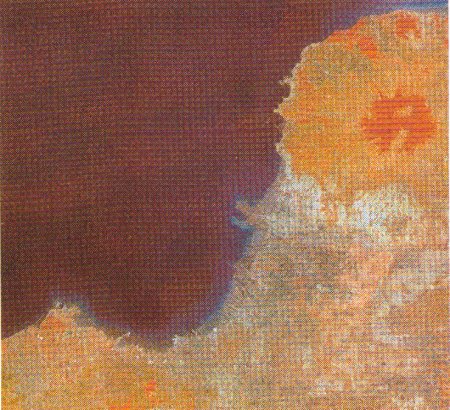
IDNDR SPECIAL PROJECT
I-2:Disasters Caused by Floods and Geomorphologic
Charges and Their Mitigation
The following are our group's activities in 1995 to conduct studies on the hazards caused by floods and geomorphologic changes and to establish more reliable methods to predict and mitigate disasters.
(1)Application of GIS:
In September 1995,Dr.Takara visited the Experimental Station for River Engineering (ESRE), Research Institute for Water Resources Development, Ministry of Public Works in Surakarta. A geographic information system (GIS) was installed in the ESRE for analyses of geographic and spatial hydrologic information in the Brantas River basin, the Solo River basin, and the Semarang area. The system, which is named "Solo GIS'95", consists of hardware and an Australian GIS or image processing software, During his stay at the ESRE, he analysed remote sensing images of the Brantas River basin acquired by a Japanese Marine Observation Satellite (MOS-1b) with researchers at the ESRE: Mr. Irwan, Mr.Sudarta, Mr. Rahardjanto, Mr. Hermono, Mr. Isnugroho, and others. Though the analysis conducted during his stay is a fundamental one, the GIS can be used for various kinds of analyses for river basins in Indonesia.
(2)Semarang Basin Research:

Observation of waves and currents by a Wave Hunter (wave-current meter) in the Jepara coast should be continuously conducted for the rest of this year.
Dr.Yoshioka visited Indonesia from Sep.9 to 15 to manage the wave observation at Semarang coast in the east monsoon season. Indonesian counterparts (Dr. Syamsudin's group) had set the Wave Hunter on August 8 at the same position where they had carried out the observation in the west monsoon season (Dec. 1994-Feb. 1995). They withdrew the Wave Hunter, got the record and set wavehunter at a new position which was better than the old position to observe the wave characteristics in the Java Sea.
Prof.Takayama and Dr.Yamashita will visit Indonesia this year to carry out wave observations at the Jepara coast in the west monsoon season and to discuss with Indonesian counterparts about the next observation plan. The Pangandaran coast facing the Indian Ocean may be the new site for next wave observation. The remote sensing image of the Semarang basin in October 1991 (MOS-1b, R: 3 band, G: 2 band, B: 1 band) is seen in photo.
(3)Brantas River Basin Research:
In November 1995,Mr.Isnugroho and Mr.Sudarta visited Disaster Prevention Research Institute, Kyoto University, and discussed the research program for this year and in the future with Prof.Egashira and Dr.Takara. They decided that:
a)For 1995 and 1996,the-Barak river and the Putih river, which are tributaries of the Brantas river, are being focused on for sediment yield research, Topographic maps, remote sensing images, and hydrological data should be collected.
b)The Lesti river, which comes from Mt.Semeru, could be one of the target sub-basins, because of much sedimentation from Mt.Sumeru.
c)Mt. Merapi, which erupted in 1994,could be one of their target areas.
d)The ultimate research goals are to produce sediment hazard maps in mountainous areas and to produce flood hazard maps along the main reach of the Brantas river.
Sedimentation in the Porong river estuary (Divergent Channel of River Brantas) has been studied by Prof. Sawai's group. According to Mr.Y.Mizuhara, it is summarized as follows.
The Porong river progressed about 4 km from 1914 to 1954.The silted volume is 280 million m3 within 40 years. It progressed about 3 km from 1945 to 1964 and 2 km from 1964 to 1970.Comparing seashore lines 1985 with 1977,
a)Siltation occurred at the right bank of the short-cut channel.
b)The shore line at the left bank seems unchanged.
c)The old river courses of branches still exist and have not changed substantially.
d)Approximate volume increase in this area is around 36 million m3 in 8 years, or 5 million m3/year. Sedimentation in the estuary of the Porong river is very active and some countermeasures are needed to maintain it. Although dredging was the principal countermeasure so far, we are considering the possibility of a new method using tidal reservoir.








